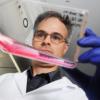Why kill the entire cell when we can just kill the mutant mito?
If there are no non-mutant mitos left in a given cell, that will kill the cell. Clonal expansion of mutant mitos leaves some cells with very few, if any, wild-type mitos. Of course, only about 1% of cells reach this state, even in extreme old age, but for certain tissues the sudden death of 1% of cells would be quite significant (the brain especially), and in muscles, while 1% of the mass might be affected, a much larger percentage of the fibers are affected (because fibers are partially mutant and partially normal), which means you could kill much more (5%, 10%, 20%?) of the muscle fibers.
All of this is predicated on de Grey's interpretations of the mosaic of COX-negative cells and the apparent clonal expansion of mutant mtDNA (I haven't read any opposing views to his, but I assume there are others which might be as valid and which might not forecast such doom and gloom).
As for cells which have a mix of wild-type and mutant DNA, this will depend on the distribution. If the cell has healthy and mutant mitos, we can kill the mutants and leave the wild-type to proliferate and rejuvenate the cell. If, however, all the mitos in the cell contain a mix of mutant and normal DNA, then either you kill the cell or you leave the mutant DNA, with no in-between option. Unless we can replace or remove the mutant DNA from individual mitos.
But, there's a good chance the percentage of cells in such states will also be very small, because of clonal expansion (they'd rapidly be overtaken by mutants), so again, perhaps only another 1% or less might be affected. There's no solid data on this number, though, or there wasn't as of a few years ago.
At any rate, it seems more likely that we'd just ablate the defective cells, rather than try to restore them, since more cells will be fully mutant than partially mutant (or so I've read, without much supporting evidence, due to lack of studies. But I'm reading papers that are a couple years old, so maybe there's new data to support or break that claim?).














































